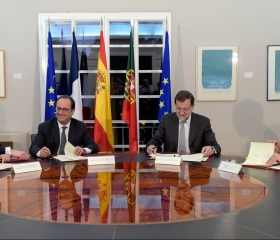The outgoing year 2015 has shown that the model of “economic independence” proposed by the Baltics cannot, after all, set an example for the rest of Europe. These countries’ energy strategy remains extremely costly because it is overly politicised.
Energy self-sufficiency is an illusion
The energy strategy of the Baltic countries is underpinned by a single political imperative: to eliminate the “Baltic island” of the EU energy system. In fact infrastructure (transport, gas, electricity and so on) is the last sphere Lithuania, Latvia and Estonia have failed to completely integrate into Europe over the past 25 post-Soviet years. The Baltic gas infrastructure has been closely linked with the eastern neighbour since the Soviet times: in 2014 Russia fully met the gas needs of these republics having exported 2.5 billion cubic metres of gas to Lithuania, 1 billion to Latvia and 0.4 billion to Estonia.
The BRELL power grid has been supplying power to Belarus, Russia, Lithuania, Latvia and Estonia since 2001. In 2009 the Ignalina Nuclear Power Plant which generated up to 70% of the gas consumed in Lithuania and made it possible to export energy was shut down on the EU’s demand. The Baltics finally turned from an energy-excessive into an energy-deficient region which has close electrical and gas bonds with Russia.
At the end of the day the efforts of the leaders of the Baltic states to resolve the current situation are driven by political phobias. On the one hand the Baltic establishment is convinced that the current Russian prices for hydrocarbons are unfair, with their leaders regularly and publicly accusing Russia of taking politically motivated gas decisions. On the other hand the ruling elites in the Baltic republics see this state of affairs as a threat to their national security. After the start of the Ukrainian crisis, which weakened the links between the Baltics and Russia in spheres ranging from politics to humanitarian issues, these fears increased as Vilnius, Riga and Tallinn stepped up their efforts to make their countries part of the EU “energy mainland.”
They propose a four-pronged effort to rectify the situation: to develop nuclear power, extract shale gas on their own territories, link up their power grids with those of EU neighbours and import liquefied gas. The first two points may in theory form the basis of energy independence for these countries, however it was in these areas that the Baltic countries’ efforts failed dismally. Poland’s withdrawal from the new Lithuanian nuclear plant project, Latvia’s and Estonia’s wobbly position on whether or not to take part in it and the 2012 referendum in which 65% of Lithuanians voted against the building of a new nuclear power plant in Lithuania – all this practically wrecked the Visaginas nuclear power plant project. At present the patient is more dead than alive: the project has not been canceled but construction has not yet started.
The development of shale gas in the Baltic never got off the ground. In Latvia politicians spoke cautiously about possible exploration for gas. Lithuania lived in expectation of a “shale revolution” from 2013 until the summer of 2014, when the American company Chevron, after winning the tender to explore and produce gas, announced that it was pulling out of the Baltics.
Liquefied gas import and power bridges, rather than ensuring true energy independence, are diversifying the former dependence. These efforts are more realistic for the Baltics, as 2015 has shown, but there are several snags.
Lithuanian templates
In recent years Lithuania has been the prime mover of the Baltic energy policy. It is not by chance that the NATO Energy Security Centre of Excellence has been located in Vilnius since 2012. In 2015 Lithuania, as planned, completed two electrical links, LitPolLink with Poland and NordBalt with Sweden. On 14 December the prime ministers of the three Baltic countries, in the presence of Lithuanian President Dalia Grybauskaite, launched these energy links amid ritual statements about “an example of cooperation to the whole of the EU” and “an end to dependence.” But they omitted to say that to synchronize the power grids of the Baltics and continental Europe the European Network of Transmission System Operators for Electricity (ENTSO-E) will launch a study since 2016 and present Lithuania, Latvia and Estonia with a set of requirements to be fulfilled in order to eliminate the “energy island.” As a result, the three Baltic countries will not be switched off the BRELL grid until about 2025 and further investments would be needed to comply with the ENTSO-E technical standards.
The situation in the gas sphere is no less complicated as the Baltic countries need two liquefied gas terminals to achieve “energy independence” from Russia. The building of a regional LNG infrastructure financed out of the EU budget was delayed by debates about the location of the terminal and other technical quarrels between the partner countries. The problems were only settled by the autumn of 2015. In October an ad hoc European Commission group decided that the most suitable site for the construction of the terminal with a capacity of between 4 and 8 billion cubic metres was Muuga Harbour in Estonia. The terminal, along with the Balticconnector gas pipeline linking Estonia and Finland, is to go into operation in 2019. However, the experience of the only working LNG terminal in the region so far shows that it will by no means solve the “energy dependence” problem.
The case of the Lithuanian LNG terminal in Klaipėda launched exactly a year ago gives an idea of the economic effect of such projects in the Baltic countries. The only supplier of gas for the facility at present is Norway’s Statoil which pumps 540 million cubic metres into the system instead of the targeted 4 billion cubic metres. The exact price Vilnius pays for Norwegian gas has not been disclosed. However, there is ample indirect evidence that provides an answer to the key question: has the LNG terminal given Lithuania access to cheaper energy?
First, even before the terminal was launched Lithuania passed legislation making it mandatory for energy companies to buy at least 20% of their gas from the new terminal in Klaipėda. Surely, marketing cheaper and more competitive gas would not have required administrative support.
Secondly, before launching the terminal in October 2014 the Norwegian Minister of EEA and EU Affairs, Vidar Helgesen, made it very clear that if Gazprom cuts the price for natural gas and it would not make economic sense for Lithuania to buy the products from the LNG terminal Statoil would not cut the gas price without some extra reason. This means that the principle of competition in this case does not work de facto. And anyway, what would cause Norway to cut its prices if Lithuanian companies are obliged to buy gas from the LNG terminal?
Thirdly, and lastly, six months after the launching of the Klaipėda terminal the state-owned company Klaipėdos nafta (which operates the facility) admitted that it was negotiating with Norway’s Statoil to reduce the amount of gas purchases.
As a result, the only element of the Baltic “energy independence” strategy that has been implemented in the region so far, has failed to solve its task оf providing Lithuania with cheaper gas than it buys from Gazprom at “politically motivated” prices. So far there is nothing to suggest that by 2019 the conditions will change so much that the situation with the regional LNG terminal in Muuga will be any different from that of the Klaipėda project.
Teaching the wrong things
In spite of the highly controversial energy strategy of the Baltic republics, their leadership is touting these achievements as an example for the whole of Europe. The Western EU countries of course also have fears connected with their dependence on Russian gas supplies. Russia meets about a third of the European Union’s gas needs, with Poland, Italy and Germany accounting for 60% of that amount. Germany, the biggest consumer in the European Union, buys 33% of Russian gas going to the EU. However, recent events show that these fears have not yet resulted in the West European energy sphere being totally dictated by politics. In spite of the tense relations between the EU and Russia and the “sanctions war,” in September 2015 Germany and France signed an agreement with Gazprom to build a 55 billion cubic metres a year Nord Stream 2 pipeline.
As expected, the East European champions of the “energy independence” strategy, including Lithuania, Latvia and Estonia, are the fiercest opponents of the project. Their argument predictably is that preserving the gas transportation route via Ukraine meets the EU’s strategic interests in terms of energy security and strengthens stability in Eastern Europe. The argument of course is not about a single project, it signifies a clash of two views on Europe: the pragmatic view which, for all the reservations, puts economic feasibility first, and the ideological approach which puts economic benefits on the back burner compared with the plan to distance the EU from Russia in every possible area.
That is why, with Nord Sream 2 being built along the borders of the Baltic states, the leaders of these countries put their stake on the import of liquefied gas, especially from the USA. In February 2016 Lithuania will become one of the first countries to receive American LNG. The volume and price of shipments are not yet known, but in the event it does not matter very much, as the preceding policy of Lithuania and the other Baltic countries leaves no doubt that American gas will find a buyer in the region even though the devaluation of the rouble enables Gazprom to pursue a more flexible price policy in the EU. Perhaps this is the reason why the Klaipėda terminal has been the first to receive American gas: it bought expensive Norwegian gas, so why not buy expensive American gas? In exchange the country has an extra chance of playing its favourite role of “the best European”, an example for other EU countries and their “laggard” neighbours.
In short, in the near future the “energy independence” of the Baltic countries will remain just a political project for regional consumption, a dream of eliminating the “energy island” for which neither the budget nor the purses of consumers should be spared. Significantly, in March 2015 the Lithuanian Minister of Enegry Rokas Masiulis eclared that Lithuania would stop buying gas from Russian in a year’s time, while 9 months later the country’s Prime Minister Algirdas Butkevičius admitted the need to sign a new agreement with Gazprom [1]1. This brings out the essence of the Baltic concept of “energy independence” which Vilnius, Riga and Tallinn are trying to foist on the entire EU. As long as West European capitals put economics above politics, their attempts will be futile.
1. Lithuanian Prime Minister Says a New Agreement with Gazprom is Needed – http://ru.delfi.lt/news/economy/premer-litvy-novyj-dogovor-s-gazpromom-nuzhen.d?id=69849316






